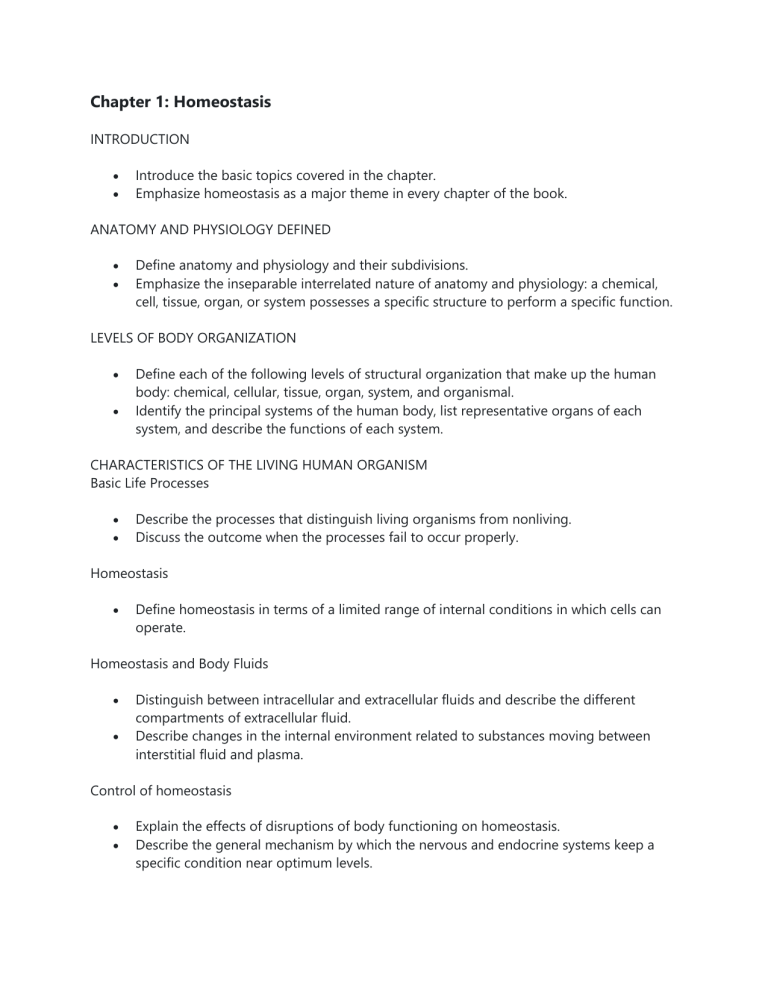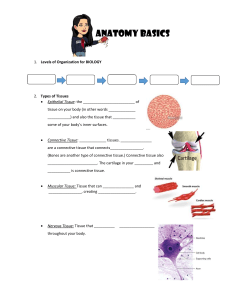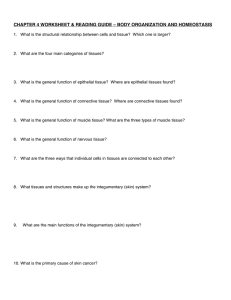
Chapter 1: Homeostasis INTRODUCTION Introduce the basic topics covered in the chapter. Emphasize homeostasis as a major theme in every chapter of the book. ANATOMY AND PHYSIOLOGY DEFINED Define anatomy and physiology and their subdivisions. Emphasize the inseparable interrelated nature of anatomy and physiology: a chemical, cell, tissue, organ, or system possesses a specific structure to perform a specific function. LEVELS OF BODY ORGANIZATION Define each of the following levels of structural organization that make up the human body: chemical, cellular, tissue, organ, system, and organismal. Identify the principal systems of the human body, list representative organs of each system, and describe the functions of each system. CHARACTERISTICS OF THE LIVING HUMAN ORGANISM Basic Life Processes Describe the processes that distinguish living organisms from nonliving. Discuss the outcome when the processes fail to occur properly. Homeostasis Define homeostasis in terms of a limited range of internal conditions in which cells can operate. Homeostasis and Body Fluids Distinguish between intracellular and extracellular fluids and describe the different compartments of extracellular fluid. Describe changes in the internal environment related to substances moving between interstitial fluid and plasma. Control of homeostasis Explain the effects of disruptions of body functioning on homeostasis. Describe the general mechanism by which the nervous and endocrine systems keep a specific condition near optimum levels. Define the major components of a feedback system and explain their role in homeostasis of a few controlled conditions. Describe the difference in purpose and operation of negative versus positive feedback systems. Illustrate how the components of the negative feedback system correspond to body structures. Work through the sequence of events of the cardiovascular system’s response to a blood pressure that is too high. Work through the sequence of interactions of a positive feedback system with respect to uterine contraction, from original stimulus to delivery of the infant. Chapter 2: Chemical Bonds, Water, pH, Carbs, Lipids, Proteins and Nucleic Acids INTRODUCTION Consider how atoms bond together in the body to form molecules. Discover how atoms and molecules release or store energy in processes known as chemical reactions. Discover how water is involved in nearly every chemical reaction. Define matter and mass. HOW MATTER IS ORGANIZED Chemical Elements Identify the principal chemical elements of the human body by their names and chemical symbols. Structure of Atoms Describe each component of an atom in terms of its relative position, charge, and mass. Ions, Molecules, Free Radicals, and Compounds Distinguish among ions, molecules, free radicals, and compounds. Describe the effects of free radicals on health. CHEMICAL BONDS Describe the significance of the valence shell electrons. Explain the octet rule. Ionic Bonds Explain why and how an atom can lose or gain electrons, and what the resulting balance between numbers of electrons and protons produces, as with sodium and chlorine. Note that when the attraction for electrons (electronegativity) between adjacent atoms is very different, one will pull electrons from the other, which produces oppositely charged ions that are attracted to each other and thus form an ionic bond. Describe what happens to most ionic molecules when put into water. Covalent Bonds Note that when atoms have a more similar attraction for external electrons, they share pairs of electrons (one from each atom) to form each single bond until all atoms in a molecule effectively fill their outer shells. Distinguish among single, double, and triple covalent bonds. Describe what happens to the distribution of electrons and charge in a covalent bond when the atoms have slightly different attractions for the electrons, as with carbon and oxygen, or in water molecules (distinguish between nonpolar covalent and polar covalent bonds). Hydrogen Bonds Describe the strength of the bond formed when a hydrogen atom covalently bound to one atom is also strongly attracted to an atom on a nearby molecule. Describe the effect on the overall shape of a large molecule due to a great number of hydrogen bonds between different parts of that molecule. Explain how hydrogen bonds result in the cohesion of water molecules and how this cohesion creates a high surface tension which is very important to the body. CHEMICAL REACTIONS Define a chemical reaction. Explain the differences between substrates and products of a chemical reaction. Forms of Energy and Chemical Reactions Define energy and distinguish between potential and kinetic energy. Discuss chemical energy and explain the law of conservation of energy. Energy Transfer in Chemical Reactions Compare and contrast exergonic and endergonic reactions. Explain how activation energy is required to produce a chemical reaction and how concentration and temperature influence the rate of reaction. Describe the role of catalysts in chemical reactions. Types of Chemical Reactions Give an example of synthetic (anabolic) reactions that occur in the body and note that they usually require energy from a molecule called ATP. Emphasize that decomposition (catabolic) reactions are used to obtain energy from food that is stored in a molecule called ATP. Describe what is meant by an exchange reaction. Note that most chemical reactions in the body are reversible because they are performed by special molecules called enzymes. INORGANIC COMPOUNDS AND SOLUTIONS Distinguish between inorganic and organic compounds. Water Explain the importance of water in living systems. Explain the properties of water that make it an excellent solvent in a solution. Explain the terms used to designate the constituents of a solution. Explain the reason for the high heat capacity of water. Discuss the high heat of vaporization of water. Describe the lubricating effects of water in the body. Solutions, Colloids, and Suspensions Compare and contrast mixtures, solutions, colloids, and suspensions. Describe how solutions are expressed by percent and in units of moles per liter. Inorganic Acids, Bases, and Salts Indicate the general properties of acids, bases, and salts, as well as how they are related in chemical reactions. Acid-Base Balance: The Concept of pH Define pH in terms of hydrogen and base (hydroxide) ion concentration and be able to recognize acidic and alkaline solutions in terms of pH values.. Maintaining pH: Buffer Systems Define a buffer in terms of its ability to prevent large changes in [H+] due to strong acids and bases, in addition to the general mechanism. Use carbonic acid as an example of the response of a buffer to the addition of H+ or base (OH-) to prevent changes of [H+] in solutions. ORGANIC COMPOUNDS Carbon and Its Functional Groups List the properties of carbon that make it particularly useful to living organisms. Describe the functional groups of organic compounds. Discuss the fact that many organic molecules are macromolecules which are polymers formed by linking together monomers. Carbohydrates List the major forms of carbohydrates (sugars, starches, glycogen, and cellulose), and describe their functions. Discuss what is meant by a simple sugar. Discuss how a disaccharide is formed. Discuss the role of glycogen in the body. Lipids Discuss the chemical makeup and properties of lipids. Discuss the properties of saturate and unsaturated fatty acids Describe the role of fatty acids in disease and health Discuss the properties of triglycerides and their function. Distinguish among saturated, monounsaturated, and polyunsaturated fats Describe the structure and role of phospholipids. Steroids Discuss the role of cholesterol in the body. Proteins Describe the basic amino acid structure and how amino acids are joined to form polypeptides. Describe how a chain of amino acids interacts with itself to produce the four levels of structural organization and provide examples of where these are seen in anatomy. Discuss the what happens to a protein’s function when it is denatured. Describe the properties of enzymes. Describe the general operation of enzymes in terms of catalysis and the conditions needed to execute essential chemical reactions of metabolism. Nucleic Acids: Deoxyribonucleic Acid (DNA) and Ribonucleic Acid (RNA) Note the two general types of nucleic acids (DNA and RNA) and their role in heredity and protein production. Discuss the structural differences between DNA and RNA. Adenosine Triphosphate Discuss the structure and function of ATP. Briefly discuss the phases of cellular respiration. Chapter 3: Different parts of a cell, active versus passive plasma membrane: INTRODUCTION Define a cell Describe the purpose of cell division. Relate the essential importance of the cellular level of organization to all life forms. PARTS OF A CELL Describe the three principal parts of a cell THE PLASMA MEMBRANE Describe how the “fluid mosaic model” concept appropriately describes the nature and structure of the plasma membrane. Structure of the plasma membrane Explain how the chemical nature of the distinct regions of phospholipids automatically produces a lipid bilayer in a water solution, with a range of properties Describe the function of cholesterol and glycolipids in membranes. Distinguish between integral and peripheral proteins in cell membranes. Functions of Membrane Proteins Compare and contrast the chemistry and function of the classes of membrane proteins, including ion channels, transporters (carriers), receptors, enzymes, linkers and cell identity markers Membrane Fluidity Discuss the fluidity of membranes and the mobility of membrane lipids and proteins. Explain how cholesterol modifies membrane fluidity. Membrane Permeability Explain the mechanisms and factors involved in the selective movement of materials across the cell membrane. Gradients Across the Plasma Membrane Define a chemical and electrical gradient and the predominant ions involved on opposite sides of the plasma membrane. Explain how an electrical gradient leads to the membrane potential that exists in cells of the body. TRANSPORT ACROSS THE PLASMA MEMBRANE Distinguish between passive and active processes, including direction of particle movement and energy requirements. Passive processes Explain how the kinetic energy of random motion and concentration differences.drive diffusion and may result in equilibrium. List and explain the factors that influence the diffusion rate of substances in solution. Explain the concept of simple diffusion and list substances that pass through the bilayer by simple diffusion. Explain the differences between simple and facilitated diffusion. Describe the the process of channel-mediated facilitated diffusion and identify substances transported by the process. Describe the the process of carrier-mediated facilitated diffusion and identify substances transported by the process. Explain the process of osmosis as the net movement of a solvent through a selectively permeable membrane Discuss the roles of hydrostatic pressure and osmotic pressure in regulating osmosis. Show the relation of osmotic pressure to tonicity by the effect on red blood cells of different concentrations of solute in a surrounding solution Active Processes Define active process and describe the energy source used to drive the process. Describe the process of primary active transport, relating the process to the sodium pump and the pump’s function Describe the process of secondary active transport and the role of symporters and antiporters and relate its function. Describe the two main types of vesicular transport between a cell and its extracellular fluid. List and explain the steps involved in receptor-mediated endocytosis Describe the process of phagocytosis and explain its importance. Describe the process of pinocytosis and explain its importance. Describe the process of exocytosis and explain its importance. Describe the process of transcytosis, relating the role of both endocytosis and exocytosis. Compare and contrast the mechanisms of the transport processes and list substances that are moved by the processes CYTOPLASM List the two components of the cytoplasm. Cytosol Describe the elements of the cytosol and their function. Organelles Describe the basic structural features and functions of organelles. Distinguish between membranous and nonmembranous organelles. Distinguish the characteristics and functions of microfilaments, microtubules, and intermediate filaments Show the relationship of cytoskeletal elements to centrioles and the centrosome and note their purpose in dividing and nondividing cells Describe the arrangement of microtubules in flagella and cilia that allow these projections to perform the different types of transport movements Indicate the origin and components of ribosomes that allow them to produce proteins, and their association with other organelles in this process Compare and contrast the two forms of Endoplasmic reticulum Describe the functions of rough ER. Describe the functions of smoth ER. Describe the structure of the Golgi appratus Describe how the Golgi apparatus conducts the processing and directing of newly synthesized molecules Delineate the role of lysosomal enzymes in protection, digestion, and recycling of external and internal substances. Describe the enzymes and reactants peroxisomes use to deactivate potentially toxic molecules. Describe the role of proteasomes. Describe the role of mitochondria in producing the energy-storage molecule ATP. NUCLEUS Discuss the morphology and function of the nuclear envelope, nucleoli, and hierarchical levels of chromatin. PROTEIN SYNTHESIS Accentuate that DNA acts by coding for structural and functional (enzyme) proteins in a process called gene expression and identify the specific processes involved.. Transcription Describe the steps of transcription that are used to synthesize complementary sequences of three types of RNA. Translation Illustrate the relation between the codes of the DNA nucleotide triplet, the mRNA codon, and the rRNA anticodon that specifies an amino acid in the protein sequence. Go through the steps in which the molecular components of this process interact to translate the mRNA sequence into a successive coupling of amino acids in a protein. CELL DIVISION Define cell division Distinguish between somatic and reproductive cell division. Chapter 4: Cellular Junctions, Tissues: INTRODUCTION Define the relation of the cellular level to the major structures of tissues that endow tissues with distinct properties. TYPES OF TISSUES AND THEIR ORIGINS Classify the tissues of the body into four major types. Describe the type of tissues derived from the three embryonic germ layers. CELL JUNCTIONS Describe the three functions of cell junctions. Describe the five most important kinds of cell junctions. EPITHELIAL TISSSUE Describe the general functions of epithelial tissues. Describe the general features of epithelial tissue and describe their functions Covering and Lining Epithelium Note that the tissue structure is directly related to the job it has in an organ. Define the terminology that indicates the types of cell layering. Relate the terms for the variety of cell shapes with their appearance and general character. Considering the layers and cell shapes in combination, outline the classification of covering and lining epithelium. Simple Epithelium Illustrate the structure of the different simple epithelial tissues in addition to showing histological representations and examples of organs that contain them. Stratified Epithelium Illustrate the structures of the different stratified and transition epithelial tissues in addition to showing histological representations and examples of organs that contain them. Pseudostratified Columnar Epithelium Illustrate the structures of the different pseudostratified epithelial tissues in addition to showing histological representations and examples of organs that contain them. Glandular Epithelium Define a gland and distinguish between exocrine and endocrine glands. Structural Classification of Exocrine Glands Indicate how structural classification is based on numbers of associated cells and describe the single type of unicellular gland. Functional Classification of Exocrine Glands Show how functional classification is related to the mode used by the cells to deliver their secretory products. CONNECTIVE TISSUE Describe the important and prominent characteristics of connective tissue. General Features of Connective Tissue Describe the two basic elements of connective tissue. Connective Tissue Cells Discuss the cells that compose connective tissue in terms of origin, function, and mobility Connective Tissue Matrix Describe the two factors of a connective tissue matrix that bestow specific properties on the tissue.. Ground Substance Name the chemical components of ground substance and how each is responsible for differing physical consistencies of connective tissues. Discuss the role of ground substances have in joint disease. Fibers Identify the different constituents of collage, elastic, and reticular fibers, as well as the alternate structures and mechanical properties of each used in specific organs. Classification of Connective Tissue Describe the features employed to classify the range of connective tissues and the major classifications, both mature and embryonic. Types Of Mature Connective Tissue Discuss the three features of mature connective tissue. Loose Connective Tissue List the structure, function, and location of loose connective tissue. Dense Connective Tissue List the structure, function, and location of dense connective tissue. Cartilage List the structure, function, and location of cartilage connective tissue. Discuss cartilage growth and repair.. Bone Tissue List the structure, function, and location of bone connective tissue. Liquid connective Tissue List the structure, function, and location of blood connective tissue. List the structure, function, and location of lymph tissue. Membranes Describe an epithelial membrane general structure. Distinguish between an epithelial and a synovial membrane. Mucous Membranes List the location and function of mucous membranes. Serous Membranes List the location and function of serous membranes Synovial Membranes List the location and function of synovial membranes. MUSCULAR TISSUE Contrast the three types of muscle tissue with regard to external appearance and internal structure, organs of location, modes of control, nature of contraction, and function. NERVOUS TISSUE Describe the general structural features and functions of the two types of cells in nervous tissues. EXCITABLE CELLS Discuss the role of excitable cells. TISSUE REPAIR: RESTORING HOMEOSTASIS Examine the cellular requirements of tissue repair and distinguish between tissues which are and are not capable of regeneration. Compare the different processes that occur between repair of minor versus serious tissue damage. Discuss the factors of nutrition, blood circulation, and age in the tissue repair processes. Describe the formation of adhesions.




